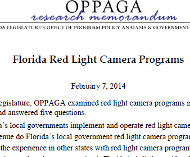Article from: www.thenewspaper.com/news/43/4333.asp
2/11/2014
Florida Legislative Report Pans Red Light Camera Safety
Florida government report found angle and rear end collision increases at intersections with red light cameras.
 Revenue from red light cameras in Florida has more than tripled in the past year, from $38 to $119 million, but a report by the state's Office of Program Policy Analysis and Government Accountability found no commensurate jump in traffic safety. In a report released Friday, the analysts for the legislative branch surveyed the 79 jurisdictions that use automated ticketing machines to determine the impact the devices have had since they were authorized in 2010.
Revenue from red light cameras in Florida has more than tripled in the past year, from $38 to $119 million, but a report by the state's Office of Program Policy Analysis and Government Accountability found no commensurate jump in traffic safety. In a report released Friday, the analysts for the legislative branch surveyed the 79 jurisdictions that use automated ticketing machines to determine the impact the devices have had since they were authorized in 2010.
According to the study, some jurisdictions made no profit from the cameras after the state took its cut and red light camera vendors, primarily American Traffic Solutions, walked away with half of the proceeds. The lack of local profit is not an issue, as reducing accidents is the stated goal for the majority of red light camera programs in the state.
"Most respondents (66 percent) cited traffic crash data as the most important factor in red light camera placement decisions," the report found.
The crash data, however, have not been favorable to camera use. The legislative analysts examined state department of transportation data on 230 intersections using cameras on state-owned roads. Up to three years worth of data were available in the before and another three in the after period.
"Angle crashes (the crashes most commonly associated with red light running) increased by 22 percent at red light camera intersections," the study found. "In addition, rear-end crashes (the crashes most commonly associated with the presence of red light cameras) increased statewide by 35 percent at red light camera intersections during the study period. Total crashes at these intersections also increased by 12 percent."
The red light camera industry trade association founded by American Traffic Solutions, the National Coalition for Safer Roads lauded the report's finding that red light camera fatalities dropped 49 percent, representing 19 fewer fatal crashes in the after period. Over this period, there were also 101 fewer head-on collisions at the same intersections. This most dangerous category of accident is "not typically identified as associated with red light running," according to the study.
Towns, cities and counties did not show much interest in using crash reduction techniques that did not generate citations.
"OPPAGA's survey results indicate that most (56 percent) of the respondents did not implement countermeasures prior to installing red light cameras," the report found. "A study published in 2004 that examined before-and-after effects of increasing the yellow light change interval on red light running found that increasing yellow light duration by 0.5 seconds to 1.5 seconds decreased red light violations by at least 50 percent."
A copy of the report is available in a 300k PDF file at the source link below.
Source: Florida Red Light Camera Programs (Florida Office of Program Policy Analysis and Government Accountability, 2/7/2014)
Permanent Link for this item
Return to Front Page
 Revenue from red light cameras in Florida has more than tripled in the past year, from $38 to $119 million, but a report by the state's Office of Program Policy Analysis and Government Accountability found no commensurate jump in traffic safety. In a report released Friday, the analysts for the legislative branch surveyed the 79 jurisdictions that use automated ticketing machines to determine the impact the devices have had since they were authorized in 2010.
Revenue from red light cameras in Florida has more than tripled in the past year, from $38 to $119 million, but a report by the state's Office of Program Policy Analysis and Government Accountability found no commensurate jump in traffic safety. In a report released Friday, the analysts for the legislative branch surveyed the 79 jurisdictions that use automated ticketing machines to determine the impact the devices have had since they were authorized in 2010.